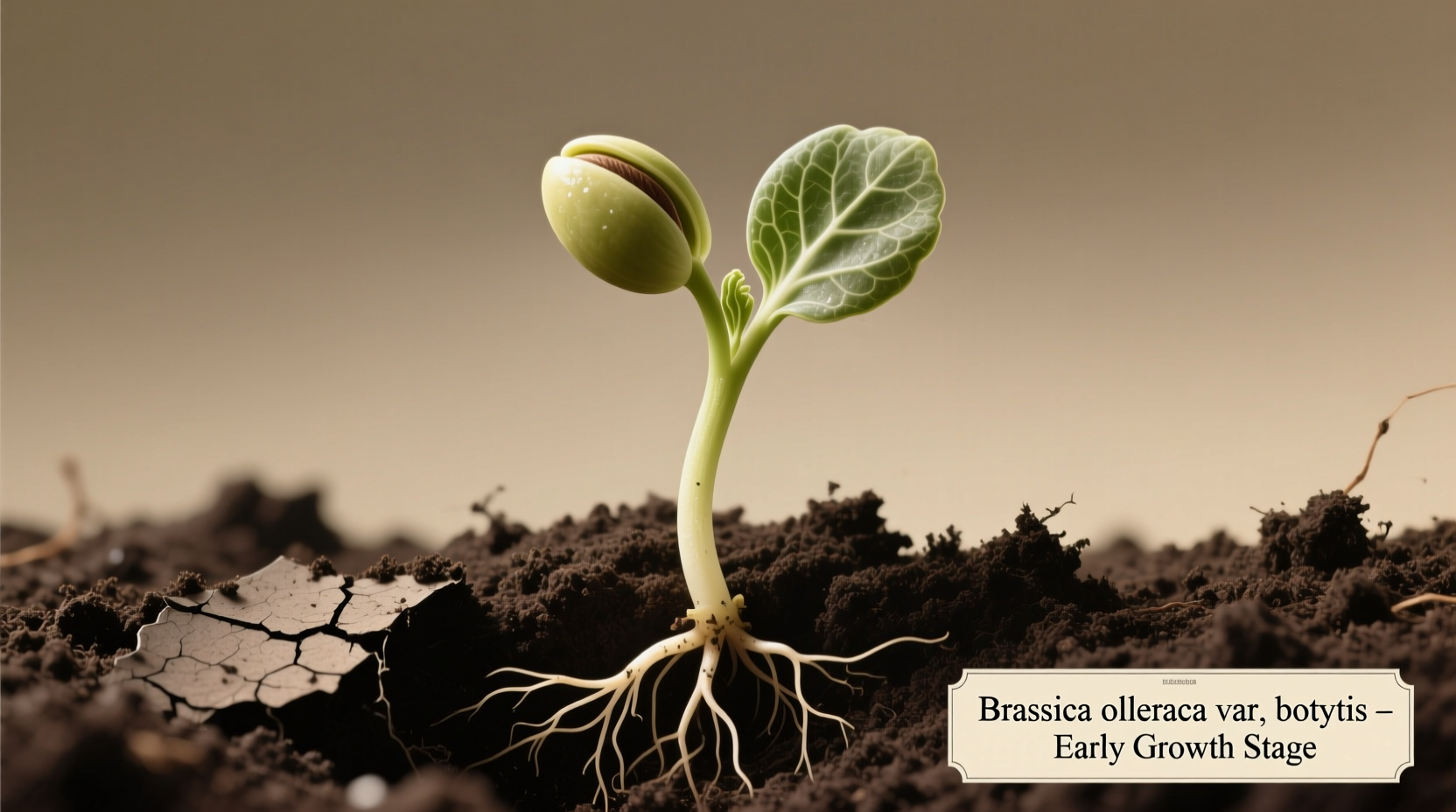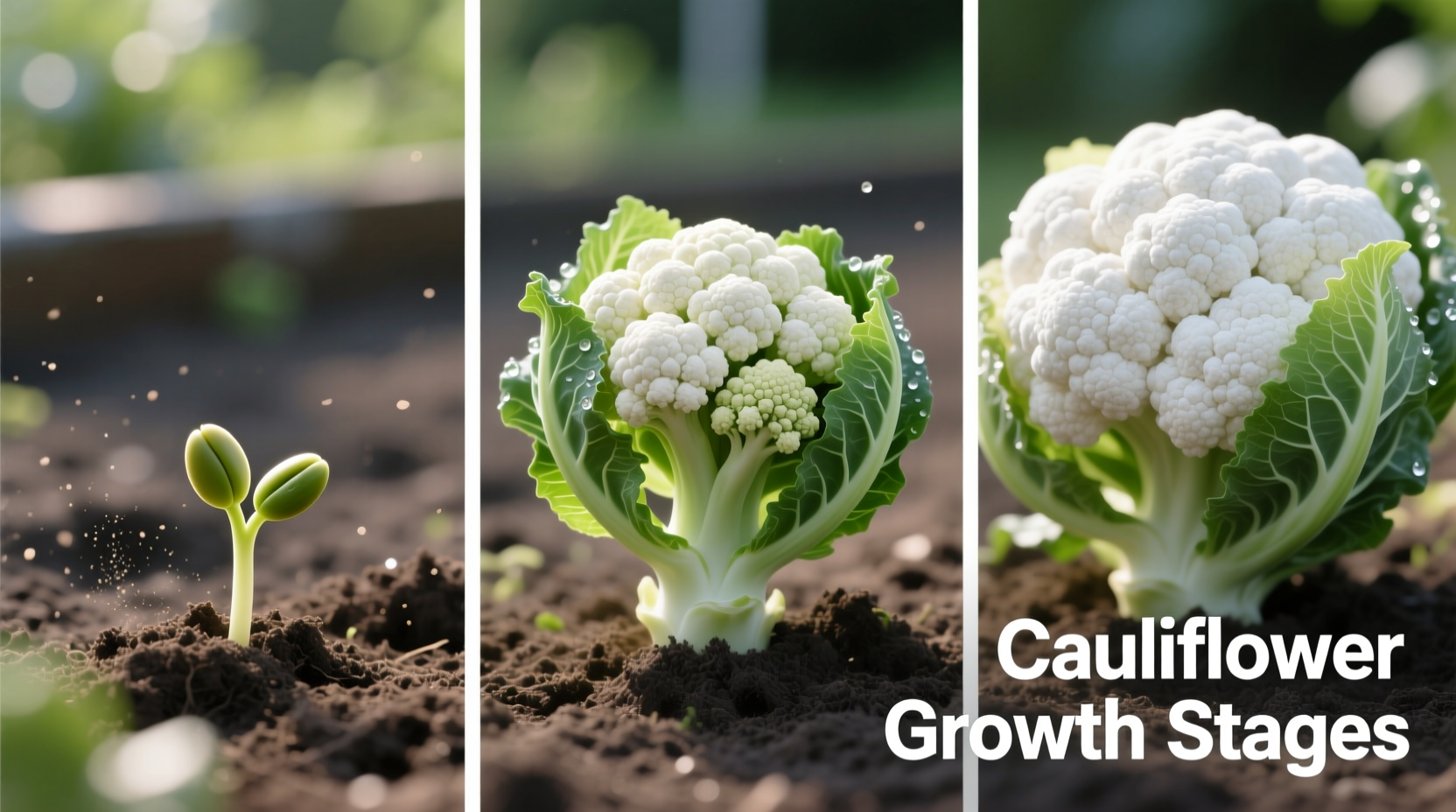Knowing exactly what to expect during each cauliflower growth phase transforms uncertain gardening into a predictable process. Whether you're a first-time grower or experienced gardener, recognizing these developmental milestones ensures you'll harvest perfect, snow-white heads every season.
| Growth Stage | Duration | Key Characteristics | Critical Care Requirements |
|---|---|---|---|
| Germination | 5-10 days | Seed swelling, root emergence | Consistent moisture, 70-80°F soil temperature |
| Seedling Development | 10-30 days | True leaves forming, root establishment | Regular watering, nitrogen-rich fertilizer |
| Vegetative Growth | 30-60 days | Rapid leaf expansion, strong root system | Deep watering, balanced fertilizer, weed control |
| Curd Initiation | 60-80 days | Small white curd formation, leaf cupping | Maintain consistent moisture, monitor temperature |
| Curd Development | 80-100 days | Curd enlargement, tight bead formation | Blanching (tying leaves), consistent watering |
| Harvest Readiness | 100-120 days | Firm 6-8" diameter head, pure white color | Harvest before curd separation begins |
Germination Stage: The Critical First Days
During the germination phase (days 1-10), cauliflower seeds absorb water and begin metabolic activity. The radicle (primary root) emerges first, followed by the shoot. Optimal soil temperature for germination ranges between 70-80°F (21-27°C), with cooler temperatures significantly slowing the process. Seeds planted too deep (beyond 0.5 inches) often fail to emerge successfully.
Common germination problems include damping-off disease (caused by fungal pathogens in cool, wet soil) and poor seed viability. To maximize success, use fresh seeds (less than one year old) and maintain consistent soil moisture without waterlogging. The University of California Cooperative Extension confirms that cauliflower germinates best in well-drained soil with consistent moisture levels during this critical phase.

Seedling Development: Building the Foundation
From days 10-30, your cauliflower transitions from seedling to established plant. The first true leaves develop after the initial cotyledons, signaling active photosynthesis. During this stage, the root system expands rapidly downward and outward. Seedlings require consistent moisture but become increasingly vulnerable to overwatering as they mature.
Transplant shock often occurs during this phase if seedlings move from controlled environments to garden beds too quickly. The USDA Agricultural Research Service recommends a 7-10 day hardening-off period where plants gradually adjust to outdoor conditions. Watch for yellowing leaves, which typically indicates nitrogen deficiency requiring immediate correction with a balanced fertilizer.
Vegetative Growth: The Leaf Expansion Phase
Between days 30-60, cauliflower focuses on leaf and root development. Healthy plants develop 15-20 large, waxy leaves that form a protective canopy over the developing head. This stage requires substantial nitrogen to support vigorous leaf growth, which directly impacts final head size.
Water deeply but less frequently during vegetative growth to encourage deep root development. The Cornell University Vegetable Program notes that inconsistent watering during this phase often leads to premature flowering (buttoning), one of the most common cauliflower cultivation problems. Maintain soil pH between 6.0-7.5 for optimal nutrient uptake during this critical growth period.
Curd Initiation: The Transformation Begins
At approximately 60-80 days, cauliflower enters the curd initiation stage where the growing point transforms from vegetative to reproductive development. You'll notice a small, white cluster forming at the center of the plant as leaf tips begin to cup inward. This transition is highly temperature-sensitive, with ideal conditions between 60-70°F (15-21°C).
Temperature fluctuations outside this range cause common problems like 'riceyness' (granular curd development) or premature flowering. The Royal Horticultural Society emphasizes that consistent moisture is critical during curd initiation - even brief drought periods can permanently damage head formation. This stage represents the plant's most vulnerable period to environmental stressors.
Curd Development: Forming the Edible Head
During days 80-100, the cauliflower curd expands rapidly while maintaining tight bead structure. Most varieties require 'blanching' during this phase - gently tying the outer leaves over the developing head to protect it from sunlight. This practice prevents chlorophyll development that would cause yellowing.
Monitor curd development daily during this stage, as heads can go from perfect to overmature in just 2-3 days. The University of Minnesota Extension reports that inconsistent watering during curd development causes 'hollow stem,' a condition where the stem develops cavities that weaken the plant structure. Maintain consistent soil moisture at 1-1.5 inches per week to prevent this common issue.
Harvest Readiness: Timing Your Pick Perfectly
Cauliflower reaches harvest readiness between 100-120 days when the head measures 6-8 inches in diameter with firm, compact curds. The ideal harvest window is narrow - wait too long and the curd will separate into 'ricey' particles. Harvest in the morning when temperatures are cooler for best quality and storage potential.
Use a sharp knife to cut the head, leaving 1-2 inches of stem and several protective leaves. Immediately cool harvested heads to preserve quality. According to agricultural research from Oregon State University, properly harvested cauliflower maintains quality for 2-3 weeks when stored at 32°F with 95% humidity - significantly longer than many gardeners realize.
Climate Impact on Growth Stages
Temperature dramatically affects cauliflower growth stage duration. In cooler northern climates, the entire process may extend to 120 days, while in warmer southern regions with proper variety selection, some cultivars mature in just 90 days. Extreme heat (above 80°F) during curd development causes yellowing and poor head formation, while temperatures below 50°F can trigger premature flowering.
Seasonal planting timing proves critical for success. The University of California's Master Gardener Program recommends planting spring crops 4-6 weeks before last frost date, and fall crops 6-8 weeks before first frost date to avoid temperature extremes during sensitive growth phases. This strategic timing ensures curd development occurs during optimal temperature windows.
Troubleshooting Common Growth Problems
Yellowing leaves often indicate nitrogen deficiency or pH imbalance, while purple discoloration typically signals phosphorus deficiency. Buttoning (small, premature heads) usually results from temperature stress or transplanting seedlings too early. Brown spots on curds frequently develop from boron deficiency, which the University of Massachusetts Extension confirms responds well to soil applications of borax at 0.5-1.0 pounds per acre.
Prevent pest damage by monitoring for aphids and cabbage loopers, which particularly target plants during vegetative growth. Use floating row covers during early growth stages to prevent infestation while allowing light and water penetration. Rotate cauliflower planting locations annually to reduce soil-borne disease pressure that affects all brassica family members.











 浙公网安备
33010002000092号
浙公网安备
33010002000092号 浙B2-20120091-4
浙B2-20120091-4